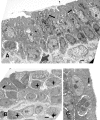Host chemokine and cytokine response in the endocervix within the first developmental cycle of Chlamydia muridarum
- PMID: 19841073
- PMCID: PMC2798225
- DOI: 10.1128/IAI.00772-09
Host chemokine and cytokine response in the endocervix within the first developmental cycle of Chlamydia muridarum
Abstract
The initial host response in a primary chlamydial infection is the onset of acute inflammation. However, we still know very little about the early temporal events in the induction of the acute inflammatory response and how these events relate to the initial chlamydial developmental cycle in an actual genital infection. Because it was critical to initiate a synchronous infection in the endocervix in the first 24 h to evaluate the sequential expression of the host response, we developed the surgical methodology of depositing Chlamydia muridarum directly on the endocervix. Cervical tissue was collected at 3, 12, and 24 h after inoculation and the expression array of chemokines, cytokines, and receptors was assessed to characterize the response during the initial developmental cycle. Polymorphonuclear leukocyte (PMN) infiltration was first observed at 12 h after inoculation, and a few PMNs could be seen in the epithelium at 24 h. Electron microscopic analysis at 24 h showed that virtually all inclusions were at the same stage of development, indicating a synchronous infection. Several chemokine and cytokine genes were expressed as early as 3 h after infection, but by 12 h, 41 genes were expressed. Thus, activation of the host response occurs both with the introduction of elementary bodies into the host and early replication of reticulate bodies. No significant response was observed when UV-inactivated organisms were inoculated into the cervix at any time interval. This model provides an ideal opportunity to investigate the mechanisms by which the early inflammatory response is induced in vivo.
Figures








References
Publication types
MeSH terms
Substances
Grants and funding
LinkOut - more resources
Full Text Sources
Medical

